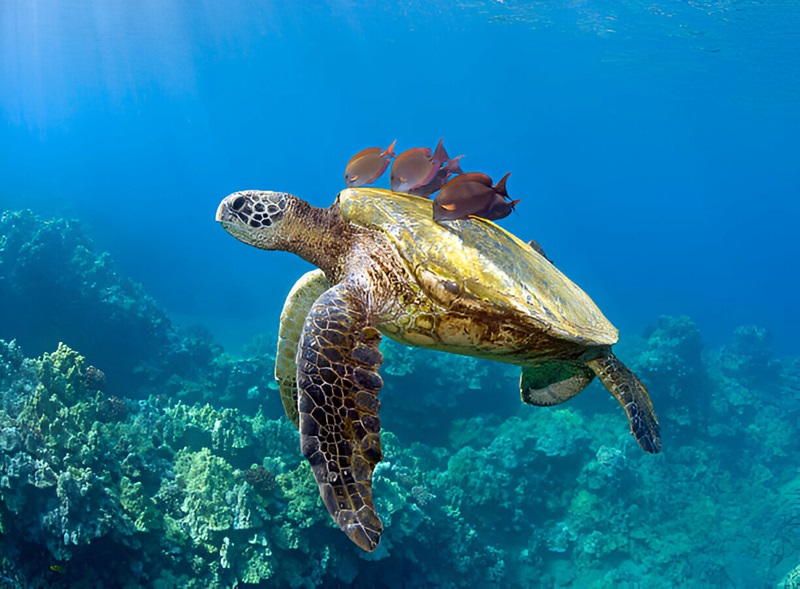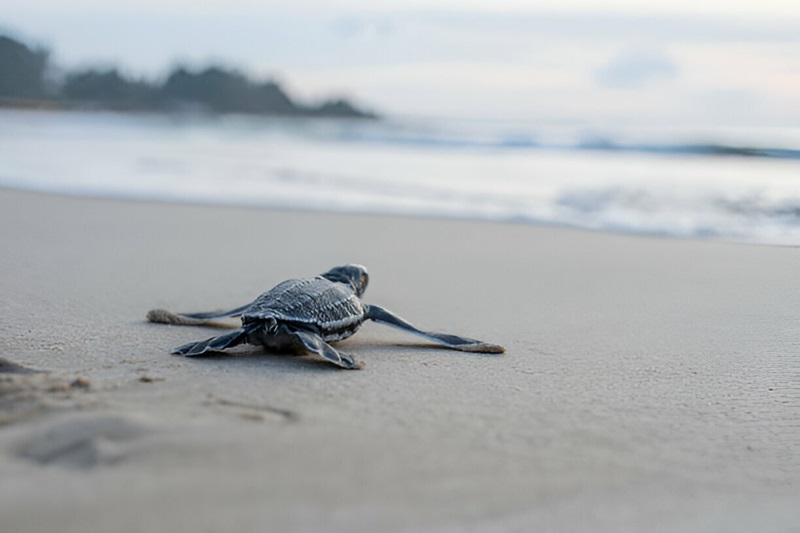Last Updated on February 28, 2025
Turtles are reptiles with hard shells for protection. They are known for their slow movement and long lifespans.
Turtles, belonging to the order Testudines, are fascinating creatures found in various habitats worldwide. They thrive in oceans, rivers, and on land. With over 300 species, each turtle exhibits unique behaviors and adaptations. Their diet varies from plants to small animals, depending on the species.
Turtles’ hard shells serve as a defense mechanism against predators. Despite their slow pace, they are adept swimmers and can travel long distances. Conservation efforts are crucial to protect these ancient reptiles from threats like habitat loss and pollution. Understanding turtles’ nature helps in preserving their existence for future generations.

The Hidden World Of Turtles
The hidden world of turtles is a fascinating realm. These creatures have been around for millions of years. They live in diverse environments and possess unique adaptations. Let’s explore their secret lives.
Habitats Across The Globe
Turtles inhabit various ecosystems worldwide. They can be found in oceans, rivers, and forests. Each habitat provides unique challenges and opportunities.
| Habitat | Characteristics |
|---|---|
| Oceans | Vast, saline waters; warm and cold climates |
| Rivers | Freshwater, flowing currents, varying temperatures |
| Forests | Dense vegetation, varied elevations, temperate climates |
Ocean turtles often migrate long distances. They rely on ocean currents to travel. River turtles face threats from pollution and habitat destruction. Forest turtles are adept at hiding from predators.
Species Diversity
There are numerous turtle species with different traits. Each species has distinct characteristics and behaviors. Let’s look at some examples:
- Green Sea Turtle: Found in tropical and subtropical oceans. They have a herbivorous diet.
- Snapping Turtle: Native to North America. Known for their powerful jaws.
- Box Turtle: Inhabit forests and grasslands. They have a hinged shell for protection.
The Green Sea Turtle is vital for marine ecosystems. They help maintain healthy seagrass beds. Snapping Turtles are essential for controlling fish populations. Box Turtles contribute to forest health by dispersing seeds.
Turtles are incredible survivors. Their diverse habitats and species reveal their adaptability. Understanding their world helps us appreciate these ancient creatures.
Turtles Through The Ages
Turtles have roamed the Earth for millions of years. These ancient creatures have fascinating stories to tell. Dive into the journey of turtles through history.
Evolutionary Journey
The evolutionary journey of turtles is remarkable. Turtles have existed for over 200 million years. They share the planet with dinosaurs. Their hard shells provided excellent protection. This adaptation helped them survive predators and harsh climates.
Early turtles had teeth and could not retract their heads. Over time, they evolved to have beak-like mouths. Fossil records show significant changes in their body structure. Today, turtles can be found in various environments. They live in oceans, rivers, and on land.
| Era | Characteristics |
|---|---|
| Triassic Period | First appeared; had teeth |
| Jurassic Period | Developed hard shells |
| Cretaceous Period | Adapted to various environments |
Historical Significance
Turtles hold a special place in many cultures. Ancient civilizations revered turtles as symbols of longevity and wisdom. In Chinese mythology, a giant turtle carries the world on its back. Native American legends often feature turtles in creation stories.
In Hindu mythology, the world rests on the back of a turtle. Sea turtles play a crucial role in marine ecosystems. They maintain the health of seagrass beds and coral reefs. Turtles have inspired countless works of art and literature. They continue to captivate our imagination today.
- Chinese mythology: Turtles symbolize immortality.
- Native American legends: Turtles in creation stories.
- Hindu mythology: World on a turtle’s back.
Understanding the history of turtles enriches our appreciation for these creatures. They are living links to our planet’s ancient past.

Secrets Of Turtle Behavior
Turtles are ancient creatures with fascinating behaviors. Their actions reveal much about their survival skills and unique adaptations. Understanding turtle behavior helps us appreciate these incredible reptiles.
Mating Rituals
Turtle mating rituals are both intricate and diverse. Males often engage in unique displays to attract females. This can include head bobbing, nuzzling, or even biting.
Some species, like the green sea turtle, travel vast distances to find mates. Mating seasons usually coincide with warmer weather, ensuring the survival of hatchlings.
During mating, males may use their long claws to grip females. This helps maintain stability in the water. The process can last from a few minutes to several hours.
Migration Mysteries
Turtle migration is one of nature’s greatest mysteries. Sea turtles, in particular, embark on long journeys across oceans.
Leatherback turtles can travel over 10,000 miles annually. They navigate using the Earth’s magnetic fields, a skill scientists still do not fully understand.
Hatchlings often return to the exact beach where they were born. This remarkable homing ability ensures the species’ survival.
Migratory routes can span continents. Turtles face many dangers along the way, including predators and human activities.
| Species | Migration Distance | Key Behavior |
|---|---|---|
| Leatherback | Up to 10,000 miles | Magnetic navigation |
| Green Sea Turtle | Up to 1,500 miles | Beach homing |
| Loggerhead | Up to 8,000 miles | Long-distance travel |
Understanding turtle behavior provides insights into their survival and helps conservation efforts. These creatures have adapted remarkably over millions of years. Their behaviors are a testament to the wonders of nature.
Conservation Challenges
Turtles face numerous conservation challenges today. These challenges threaten their survival and impact their populations globally. Understanding these challenges is key to protecting these ancient creatures.
Threats To Survival
Turtles encounter many threats in their natural habitats. Habitat destruction is a significant issue. Human activities such as deforestation, urbanization, and farming reduce their living spaces.
Pollution also poses a grave threat. Plastic waste, oil spills, and chemical runoff contaminate their environments. Turtles often mistake plastic for food, leading to injuries and deaths.
Climate change impacts turtles as well. Rising temperatures affect their nesting sites and sex ratios. Warmer sands produce more female hatchlings, disturbing population balances.
Illegal hunting and poaching add to their struggles. Turtles are hunted for their shells, meat, and eggs. This illegal trade drives many species towards extinction.
Bycatch in fishing gear is another danger. Turtles get caught in nets and fishing lines. This often results in drowning or severe injuries.
Conservation Efforts Worldwide
Many organizations work tirelessly to protect turtles. Conservation programs focus on habitat protection, anti-poaching measures, and public education.
Marine protected areas (MPAs) play a crucial role. These zones safeguard critical habitats from human interference. MPAs help maintain healthy ecosystems for turtles.
Rescue and rehabilitation centers provide care for injured turtles. These centers nurse them back to health and release them into the wild. This effort boosts turtle populations.
Community involvement is essential. Local communities participate in conservation activities. They help monitor nesting sites and reduce hum
Living With Turtles
Living with turtles can be a joyful and unique experience. These gentle reptiles have their own charm and characteristics. They can be easy to care for with the right knowledge.
Human-turtle Interactions
Turtles interact with humans in various ways. Many people keep them as pets. They can be fun and fascinating to watch. Turtles recognize their owners and show excitement during feeding time.
Pet turtles need proper care. They require a balanced diet and a clean environment. Owners should handle them gently to avoid stress. Kids love observing turtles due to their slow, deliberate movements.
Creating Turtle-friendly Habitats
A turtle-friendly habitat is crucial for their well-being. It should mimic their natural environment. You need to provide a clean and safe space.
Here are some tips for creating a perfect habitat:
- Tank Size: Ensure the tank is spacious.
- Water Quality: Keep the water clean and filtered.
- Basking Area: Provide a dry area with a heat lamp.
- Substrate: Use safe materials like gravel or sand.
- Plants and Decorations: Add plants and hiding spots.
Below is a table summarizing essential habitat elements:
| Element | Description |
|---|---|
| Tank Size | Large enough for swimming and roaming. |
| Water Quality | Clean, filtered, and regularly changed. |
| Basking Area | Dry, warm place with a heat lamp. |
| Substrate | Safe materials like gravel or sand. |
| Plants and Decorations | Live or artificial plants, hiding spots. |
Creating a proper habitat helps turtles thrive. It ensures their health and happiness. Remember, a happy turtle is a healthy turtle.
Frequently Asked Questions
What Are The Traits Of A Turtle?
Turtles have hard shells for protection. They are slow movers and can live both in water and on land. They have long lifespans and lay eggs. Turtles are also known for their retractable heads and limbs.
What Is The Natural Behavior Of Turtles?
Turtles are naturally slow-moving, aquatic, or semi-aquatic reptiles. They bask in the sun, forage for food, and migrate seasonally. Turtles are generally solitary and can live both in water and on land. They exhibit digging behavior and have strong homing instincts.
What Are 5 Facts About Turtles?
1. Turtles have existed for over 200 million years. 2. They can live both on land and in water. 3. Most turtles have a lifespan of 50 years or more. 4. Turtles lay eggs on land, even in water.
5. They have a hard shell that protects them from predators.
Do Turtles Have Personalities?
Yes, turtles have personalities. They can be shy, curious, or even bold. Each turtle shows unique behaviors and preferences.
What Do Turtles Eat?
Turtles primarily eat plants, insects, and fish. Their diet varies with species and habitat.
How Long Do Turtles Live?
Turtles can live for several decades. Some species even reach over 100 years.
Conclusion
Turtles are fascinating creatures with unique behaviors and characteristics. They play a crucial role in our ecosystems. Understanding their nature helps us appreciate their importance. Protecting their habitats ensures their survival. Let’s work together to safeguard these amazing reptiles for future generations.
Dive deeper into the world of turtles and discover their wonders.

